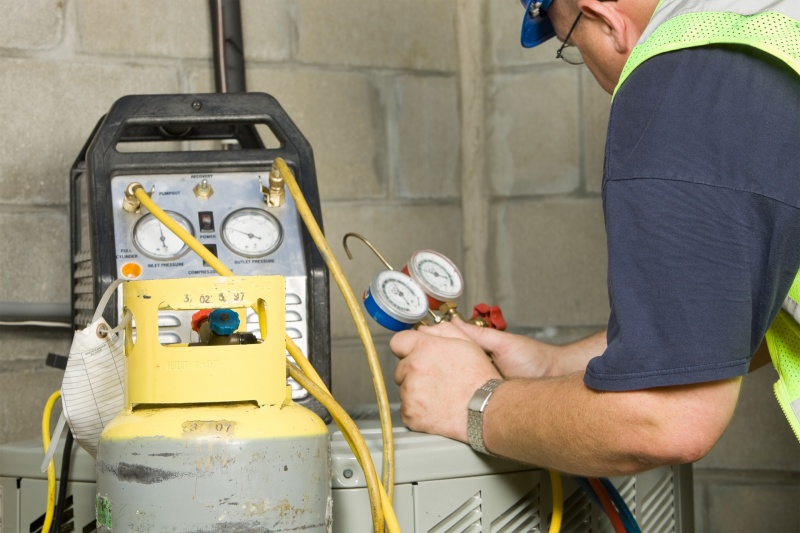A heat pump is designed to provide both heating and cooling efficiently, but its performance can decline significantly when refrigerant leaks occur. These leaks are among the most frequent reasons homeowners call for heat pump repairs. A refrigerant leak not only reduces system efficiency but can also lead to higher energy bills, uneven indoor temperatures, and even long-term damage to key components. Understanding the role of refrigerant leaks helps homeowners identify early signs and seek timely repairs. We will explore how these leaks develop, their impact on performance, and why professional intervention is crucial for maintaining long-term system health.
How Refrigerant Leaks Influence Heat Pump Performance and Repair Needs
1. Understanding the Function of Refrigerant in Heat Pumps
Refrigerant is the substance that makes heat transfer possible within a heat pump. It absorbs heat from one area and releases it in another, allowing the system to both heat and cool your home depending on the season. The refrigerant moves through coils and compressors in a closed-loop system, and its pressure levels must remain stable for optimal operation. When a leak develops, the system loses this essential balance, often requiring assistance from a plumber in Greenville, SC who is experienced in diagnosing and repairing HVAC-related issues to restore proper functionality and efficiency.
Reduced refrigerant levels make it harder for the heat pump to absorb and release heat effectively, which in turn forces the compressor to work harder. This increased workload leads to energy waste and premature wear, often prompting repair calls. Homeowners might notice that the system runs continuously, produces less heat or cooling, or fails to maintain a steady indoor temperature. These symptoms often point to refrigerant issues that require immediate attention.
2. Common Causes Behind Refrigerant Leaks
Refrigerant leaks rarely happen overnight. They develop gradually due to factors such as corrosion, vibration, or manufacturing flaws in coils and joints. Over time, the metal tubing inside a heat pump can corrode, creating small pinholes that allow refrigerant to escape. In some cases, poor installation practices can also lead to weak connections that fail under pressure.
Additionally, long-term system vibration during operation can loosen fittings or damage seals. External elements, such as moisture, chemical exposure, or improper maintenance, further increase the risk. Many homeowners are unaware that even a tiny leak can cause significant performance drops over time. Detecting the source of the leak is often complex, requiring precise tools and trained technicians. If left unattended, small leaks can escalate into costly issues that may demand a complete refrigerant recharge or component replacement. Understanding these root causes helps prevent recurring leaks and unnecessary repair costs.
3. Identifying Early Signs of a Refrigerant Leak
Recognizing early signs of refrigerant loss can prevent major system failures. Homeowners should pay attention to indicators such as weak airflow, unusual hissing sounds, or ice forming on the coils. A heat pump that struggles to reach set temperatures or runs for extended periods without cycling off may also be low on refrigerant. In many cases, higher energy bills are the first noticeable clue. The compressor, which drives the refrigerant through the system, must work longer and harder when levels are low, consuming more power.
If a leak continues unchecked, it can eventually damage the compressor — one of the costliest components to replace. Another sign includes warm air blowing during cooling cycles or cool air during heating cycles, signaling an imbalance in the heat exchange process. Being aware of these signs allows for faster response, minimizing both repair costs and energy waste over time.
4. The Repair Process and Why Professional Service Matters
Repairing a refrigerant leak involves more than simply adding more refrigerant. The system must first be properly inspected to locate the exact source of the leak. Once identified, the damaged area is sealed, and the system is evacuated to remove any air or moisture. Afterward, the correct type and amount of refrigerant are recharged into the system to restore proper pressure levels. This process requires specialized tools and a thorough understanding of refrigerant handling and safety.
Homeowners should avoid temporary fixes or DIY solutions, as refrigerant handling without certification can lead to safety hazards and environmental harm. Professional technicians utilize advanced leak detection methods, including electronic detectors and UV dye testing, to ensure accuracy. Their goal is to restore both efficiency and reliability. Choosing timely professional repair ensures your heat pump continues to perform efficiently, reduces future repair frequency, and extends the system’s lifespan.
5. Long-Term Prevention and Maintenance Strategies
Preventing refrigerant leaks starts with consistent maintenance. Scheduling annual inspections enables technicians to identify pressure inconsistencies or small leaks before they develop into major issues. Cleaning coils, checking seals, and tightening connections during routine visits help maintain the integrity of the refrigerant circuit. Homeowners should also ensure that the outdoor unit is clear of debris and that airflow is unobstructed. Regular maintenance not only prevents leaks but also ensures balanced refrigerant levels and peak performance year-round.
Some homeowners also opt for proactive leak detection systems that alert them to pressure drops or refrigerant loss early on. Using a reliable service provider ensures that preventive steps are followed carefully. Consistent upkeep not only reduces repair calls but also contributes to lower energy consumption, improved comfort, and a longer-lasting heat pump system. Maintenance is the key to keeping small problems from turning into expensive repair projects.
Refrigerant leaks are more than just a minor inconvenience — they are a critical issue that directly affects the efficiency and longevity of your heat pump. From energy loss to potential compressor damage, these leaks often necessitate repair calls. By recognizing early warning signs and understanding how leaks develop, homeowners can take timely action to safeguard their systems. Regular maintenance and professional inspections remain the most effective ways to prevent refrigerant-related problems.
